
Sitka Sen. Bert Stedman is determined not to spend down Alaska’s Permanent Fund to balance the state’s budget, even if it means residents won’t be seeing a $3,000 dividend this fall.
Stedman delivered a legislative update to the Sitka Chamber of Commerce on Wednesday (3-31-21), and outlined some of the challenges as legislators balance the realities of a dwindling state savings account against the temporary influx of over $1 billion in federal relief money.
Listen/watch Sen. Stedman’s full legislative update to the Sitka Chamber of Commerce.
Stedman is a Republican and a conservative, and he has watched in dismay as state government — largely controlled by his party — has failed to address Alaska’s systemic financial problems.
“We all understand we’ve been running at deficit spending for quite some time,” he said, “and we’ve spent down our savings accounts precipitously — well over $10 billion — and we’ve got about a billion left in our main savings account.”
That savings account is the Constitutional Budget Reserve, or the CBR.
Stedman co-chairs the Senate Finance Committee, and oversees the state operations budget. Last December, Gov. Mike Dunleavy, also a Republican, unveiled a budget proposal for the state that would draw the usual 5-percent from the Permanent Fund to pay the state’s bills, plus another $3 billion to pay out his promised $3,000 dividend.
The only problem: The governor’s not in charge of the budget; legislators like Stedman are. Or in Stedman’s words, “he proposes, and we dispose.”
Stedman says a $3,000 dividend is “extremely unlikely,” because it would put Alaska on a slippery slope toward spending the Permanent Fund itself.
“We would still have a substantial budget deficit and we’d be eroding the Permanent Fund,” Stedman said, “and some of us are very concerned that if we erode the Permanent Fund Earnings Reserve — which is the spendable portion of the Permanent Fund — we have nowhere else to go.”
Stedman said that although there’s been discussion about tax structure this session — both oil taxes and sales taxes — nothing is likely to move through the legislature this year. Like legislative bodies everywhere in the country, Stedman says he and his colleagues are focused on the influx of cash from the “American Rescue Plan,” the $1.9 trillion relief bill which President Biden signed into law earlier in March. That amounts to over $1 billion for Alaska, including $359 million for the state’s schools.
Stedman says there’s some flexibility in appropriating this money, and it’s occupying a lot of the legislature’s attention.
“We’re looking at breaking it up over 2 or 3 years, so we don’t waste it,” said Stedman.
Unlike earlier relief bills, the American Rescue Plan has a longer horizon, with a spending deadline at the end of 2024.
Where that money will land has yet to be determined. Stedman thinks there will be some for the Alaska Marine Highway, and that there might be a way to fold relief funding into SEARHC’s new hospital project in Sitka, which could require substantial infrastructure upgrades to accomplish. And he also wants to look at expanding classrooms at Mt. Edgecumbe High School, replacing the World War II vintage dorms, and funding an endowment for the school.
Stedman sees these projects as a way to balance the “expensive roads and bridges” that are needed in other regions of the state.
But some other things were going to be a tougher sell: namely, relief for the visitor industry. Southeast and the Denali Borough are the two hardest-hit areas by the two-year hiatus in cruising. Stedman didn’t go out of his way to raise hopes for relief here, but he would try. “Now that’s part of the solution,” he said, “to get your colleagues to recognize you’ve got an impact, it’s another challenge to get them to support cutting funds loose to the impacted areas.”






























